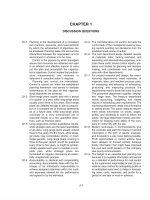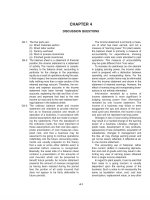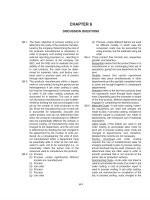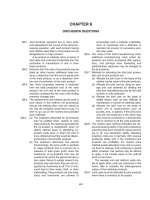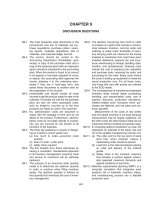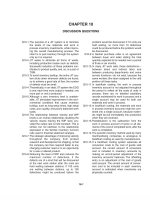Solution manual cost accounting by carter 14e ch11
Bạn đang xem bản rút gọn của tài liệu. Xem và tải ngay bản đầy đủ của tài liệu tại đây (70.25 KB, 27 trang )
CHAPTER 11
DISCUSSION QUESTIONS
Q11-1. Yes, to the extent that it is practical to measure the value added or the productivity of a
worker. However, measurement of the contribution of each individual is never exact. Also,
a business cannot pay more for materials or
labor than the sales price will recover.
Materials, workers, and machines produce
products and services. There must be a difference between revenue and costs consumed;
otherwise, the business cannot survive.
Q11-2. Productivity may be defined as the measurement of production performance using the
expenditure of human effort as a yardstick. In
a broader sense, it may be described as the
efficiency with which resources are converted
into commodities and/or services that people
want.
Q11-3. Productivity is important to a firm because
high productivity reduces the unit cost of the
output and makes the firm more competitive.
It is important to workers because their real
earnings should be increased when productivity is high. Productivity is important to society because increased productivity enables
society to get more and better output from the
basic resources of the economy.
Q11-4. To measure labor efficiency, it is necessary to
establish a standard of performance. This
means determining how much a worker
should be able to produce, or how much a
work crew should be able to produce. The
standard is determined by time and motion
study, test runs by skilled workers, and averages of past performance by skilled workers.
Q11-5. The purpose of an incentive wage plan is to
induce a worker to produce more, resulting in
a higher wage and reduced conversion cost
per unit. Frequently, machine output is limited
by worker performance. If employee performance can be increased, machine cost per unit
of production will decrease. An incentive
wage plan may also reduce loafing, indifference, and carelessness, and may generate a
cost-conscious labor force.
Q11-6. Generally, hourly earnings go up with
increased production, and labor cost per
unit of output is reduced. High production
rates also reduce overhead cost per unit of
output, which is often the most significant
savings.
Q11-7. (a) During periods of curtailed activity, it is
just as necessary to keep costs down as
it is when operating at full capacity.
Assuming that the incentive wage plan
resulted in greater labor efficiency and
lower costs per unit at full capacity, then
the labor cost per unit should be lower in
a slack period if the incentive wage scale
is continued. A shorter workweek or some
other system of sharing the work would
be indicated.
(b) Ordinarily, it is not a propitious time to initiate an incentive wage plan when a plant
is operating far below capacity, because
the worker is already fearful of something
less than full employment. If a reasonable
day’s work is being received for the going
rate of pay, postponement of the incentive
plan is indicated. However, there is a natural tendency for workers to reduce output
during such periods, thereby increasing
costs, with a tendency to bring about further reduction in the volume that can be
sold. With full explanation and understanding of the situation, the incentive
wage could be introduced with a plant
operating at 60% capacity.
Q11-8. In the straight piecework plan, each worker is
paid a certain amount for each unit produced,
while being guaranteed a base hourly wage.
In the 100% bonus plan, each worker is paid
for the standard time to complete the job or
units if the job or units are finished in standard
time or less. In the group bonus plan, workers
in a group are paid their standard hourly
wage. If the group produces units in excess of
the standard, the workers are paid for the time
saved.
11-1
11-2
Q11-9.
Q11-10.
Q11-11.
Q11-12.
Q11-13.
Q11-14.
Chapter 11
An organizational or gainsharing incentive
plan is designed to provide incentive pay to all
employees by way of an organization-wide
plan that rewards for improved productivity.
The basic concept underlying the relationship involved in the cumulative average time
learning curve model is that every time the
cumulative quantity of units produced is doubled, the cumulative average time per unit is
reduced by a given percentage.
The learning curve theory is used to solve
problems such as determining labor costs in
bids for government contracts, determining
lot costs for various stages of production
runs, predicting labor-hour requirements,
permitting the calculations of standard labor
cost variances, assisting in the evaluation of
a manager’s performance, and providing a
basis for cost control.
The financial accounting aspect is concerned
with a record of earnings of each employee
and payment of the workers. Financial
accounting records income, FICA, and other
payroll taxes and deductions withheld; provides for disbursing funds to workers and to
taxing and other agencies; reports to each
employee at least annually the amount of
wages earned and the amounts withheld for
various purposes; and records the payroll
liability and payment each payroll period.
The cost accounting aspect is concerned
with time worked on each job or in each cost
center, in order to determine the labor hours
and labor cost of production.
An efficient labor force begins with the
design of the product and an analysis of production techniques and job requirements.
With the personnel department adequately
informed about job specifications, It is the
function of this department to secure the
personnel qualified to do each job. The production planning department keeps the work
flowing smoothly. The timekeeping, payroll,
and cost accounting departments contribute
to the total efficiency by accounting for the
time purchased and by making payment for
the work as well as charging the cost to the
proper department and product.
(a) Determining labor hours worked by
each employee is primarily for payroll
purposes and financial accounting.
Q11-15.
Q11-16.
Q11-17.
Q11-18.
Q11-19.
(b) Determination of labor hours consumed
on each job or in a department is a part
of cost determination for a job or
process. It should also be a measure of
labor efficiency, since hours consumed
and productive output can be compared.
(a) The clock card shows the amount of
time an employee spent in the plant
each day of a payroll period. It is evidence that the employee’s time has
been purchased.
(b) The time ticket shows the amount of
time an employee spends each day on
each job or in each department. It is an
itemized invoice of the time that the
employee sells to the employer.
Since the clock cards show the time employees are in the plant, the first step is to make
sure no error exists on the time tickets. If the
total time shown on the time tickets is correct, then the workers spent time in the plant
when not working or not assigned to specific
jobs or departments, or when assigned to
maintenance or repair work For the time that
is idle or assigned to indirect labor, a charge
is made to Factory Overhead.
Bar codes are symbols that can be processed
electronically to identify numbers, letters, or
special characters. Bar-coded employee
identification cards or badges, and task
identifications can be used to replace clock
cards and time tickets to collect payroll data
and to measure worker activity.
Appendix One method would be to charge
the premium costs directly to the
products in the same manner as
straight-time labor costs. This
would be appropriate when particular jobs have to be rushed to
completion. A second method
would be to treat the premium as
an overhead element to be
charged to all production through
the allocation of overhead. It
would be appropriate when the
overtime is a recurring condition
normally incident to the level of
operations.
Appendix The bonus and vacation pay
should be accrued over the benefited time period. When the bonus
Chapter 11
and vacation pay are paid, the
accrued liability account is debited
and the cash and withholding
accounts are credited.
Q11-20. Appendix The recommended method in
computing costs under a pension
plan is to determine actuarially
the eventual pension payments to
covered employees and to charge
these future payments as a cost
of current production over the
expected period of active service of
covered employees. Costs based
on past services should be written
off over some reasonable period
11-3
on a systematic and rational basis
that does not distort the operating
results of any one year. These
costs are incurred in contemplation of the present and future services not only of the individual
employee, but also of the organization as a whole. Benefits of the
plan—such as improved morale,
removal of superannuated employees, and attraction of more desirable personnel—are expected to
improve the operating efficiency of
a company.
11-4
Chapter 11
EXERCISES
E11-1
ORANGE CITY CANNING COMPANY
Labor Schedule for Jaime Vasquez
For First Week in June
Hours worked ..................................................................................
Units produced................................................................................
Standard production (40 × 30) ......................................................
Efficiency ratio (1,440 ÷ 1,200) .................................................. ...
Base wage .................................................................................. ....
Weekly earnings ($9 × 40 × 120%).................................................
Effective hourly rate ($432 ÷ 40) ...................................................
Labor cost per unit ($432 ÷ 1,440) ............................................. ..
E11-2
(1)
Hours × hourly rate............ ...................
Units above standard............................
Hours saved...........................................
Value of time saved ..............................
80% of value of time saved ..................
Earnings ................................................
(2)
Efficiency ratio:
860
800
Monday Tuesday Wednesday
$64.00
$64.00
$64.00
0
10
15
.50
.75
$ 4.00
$ 6.00
$ 3.20
$ 4.80
$64.00
$67.20
$68.80 $200.00
= 107.5%
Earnings: 107.5% × $8 hourly rate × 40 hours = $344
(3)
40
1,440
1,200
120%
$
9
$ 432
$10.80
$ .30
Earnings: ($8 hourly rate + 5% rate increase) × 24 hours =
$8.40 × 24 hours = $201.60
Actual
Hours
48
48
48
48
48
%
Bonus
5.70
4.75
6.40
7.50
8.10
6.45
Base
Earnings
$ 720
666
720
684
648
$3,438
Amount
Total
Bonus Earnings
$ 41.04 $ 761.04
31.64
697.64
46.08
766.08
51.30
735.30
52.49
700.49
$222.55 $3,660.55
Overhead ConCost
version
per
Cost per
Unit
Unit
$2.087
$3.391
2.021
3.284
1.951
3.201
1.920
3.170
1.882
3.132
(2) Assuming each employee receives the base wage of $9 per hour and that all members of the crew worked the
same number of hours during the week, earnings per worker would be $366.06 for the week
($3,660.55 ÷ 10).
%
Excess
11.4
9.5
12.8
15.0
16.2
12.9
Labor
Regular
Bonus
Total
Cost
Group (Hrs. Saved
Group
per
Wage
@$12.50) Earnings
Unit
$600
$ 0
$600.00 $1.304
600
0
600.00
1.263
600
15.00
615.00
1.250
600
25.00
625.00
1.250
600
37.50
637.50
1.250
Standard
Actual
Production Production Excess
16,000
17,824
1,824
14,800
16,206
1,406
16,000
18,048
2,048
15,200
17,480
2,280
14,400
16,733
2,333
76,400
86,291
9,891
Standard
Hours for
Units
Units
Produced Produced
460
46.0
475
47.5
492
49.2
500
50.0
510
51.0
Hours
Day
Worked
Monday
80
Tuesday
74
Wednesday
80
Thursday
76
Friday
72
Total
382
E11-4
(1)
Day
Monday
Tuesday
Wednesday
Thursday
Friday
E11-3
Chapter 11
11-5
11-6
Chapter 11
E11-5
20A productivity ratio =
20A standard hours for work done ÷
20A total actual direct and indirect labor hours =
643,823 ÷ 1,525,324 = .422089
Hours needed for 20B production at 20A productivity ratio =
20B standard hours for work done ÷ 20A productivity ratio =
558,510 ÷ .422089 ..............................................................................
Less 20B total actual direct and indirect labor hours....................
Hours saved .......................................................................................
1,323,204
1,284,983
38,221
Value of wages saved = hours saved × 20B
average hourly pay plus labor fringe benefits =
38,221 × $14.70 = $561,849
Employee gainsharing incentive total =
value of wages saved × 50% =
$561,849 × 50% = $280,924.50
Gainsharing incentive per employee =
total gainsharing incentive ÷ number
of eligible employees =
$280,924.50 ÷ 755 employees = $372.09
E11-6
1
2
4
8
16
batch .............................................................
batches ............................................................
batches ............................................................
batches ............................................................
batches ............................................................
$60,000
$48,000
$38,400
$30,720
$24,576
(80%
(80%
(80%
(80%
of
of
of
of
$60,000)
$48,000)
$38,400)
$30,720)
E11-7
Bridge
Number
1
2
4
8
×
Cumulative Average
Required Weeks per Bridge
100
80 (100 weeks × 80%)
64 (80 weeks × 80%)
51.2 (64 weeks × 80%)
7 additional bridges must be built in order to bring the cumulative average below 52
weeks.
Chapter 11
11-7
E11-8
(1)
The schedule below demonstrates the 80% learning curve that the company
expects to experience in producing the time devices:
Cumulative
Lots
1
2
4
8
×
Cumulative
Average
Time
90.00 hours
72.00
57.60
46.08
=
Cumulative
Time
90.00 hours
144.00
230.40
368.64
At an 80% learning factor, the cumulative time to produce 8 lots should be
368.64 hours. At a standard labor rate of $9 per direct labor hour, the standard
amount for total direct labor cost should be set at $3,317.76 (368.64 × $9).
(2)
The company should establish the standard for direct labor time equal to the
marginal direct labor time required to produce the eighth lot, providing steadystate production occurs after the eighth lot. To assure that this standard time
will be accurate, the company should:
(a) Keep accurate records through the first 8 lots to determine if an 80% learning factor is experienced.
(b) Continue to keep accurate records for each successive production lot to
provide a basis for:
1. Conformance to expectations about labor time (i.e., steady state production after 8 lots), or
2. Determining when steady-state production does occur.
E11-9 APPENDIX
(1)
Overtime premium charged to production worked on during the overtime
hours:
Work in Process...............................................................
Payroll (40 hours × $9) + (6 hours × 1.5 × $9) ......
(2)
441
441
Overtime premium charged to factory overhead:
Work in Process (46 hours × $9) ...................................
Factory Overhead Control (6 hours × .5 × $9) ........... ..
Payroll ......................................................................
414
27
441
11-8
Chapter 11
E11-10 APPENDIX
Subsidiary
Record
Factory Overhead Control ................................
Bonus Pay ........................................
Vacation Pay ....................................
Liability for Bonus ....................................
Liability for Vacation Pay ........................
1
2
Dr.
201.60
Cr.
134.401
67.202
134.40
67.20
($10 + $32) × 40 hours × 4 weeks = $6,720 ÷ 50 weeks = $134.40
($10 + $32) × 40 hours × 2 weeks = $3,360 ÷ 50 weeks = 67.20
E11-11 APPENDIX
Factory Overhead Control ($35,000 × 28%) ...............
9,800
Marketing Expenses Control ($8,000 × 28%) .............
2,240
Administrative Expenses Control ($7,000 × 28%) .....
1,960
Liability for Pensions ($50,000 × 7.8%) ............
3,900
Liability for Other Postretirement Benefits
($50,000 × 2.3%) ............................................
1,150
FICA Tax Payable ($50,000 × 7.5%) ...................
3,750
Federal Unemployment Tax Payable
($50,000 × .8%) ..............................................
400
State Unemployment Tax Payable
($50,000 × 4.6%) ............................................
2,300
Workers’ Compensation Insurance Payable
($50,000 × 1%)................................................
500
Medical Insurance Payable ($50,000 × 4%) .......
2,000
CGA-Canada (Adapted). Reprint with permission.
E11-12 APPENDIX
(1)
The entry to record the payroll liability:
Payroll ............................................................�������������������������������������������������������������������������������������������������������������������������������������������������������������������������������������������������������������������������������������������������������������������������������������������������������������������������������������������������������������������������������������������������������������������������������������������������������������������������������������������������������������������������������������������������������������������������������������������������������������������������������������������������������������������������������������������������������������������������������������������������������������������������������������������������������������������������������������������������������������������������������������������������������������������������������������������������������������������������������������������������������������������������������������������������������������������������������������������������������������������������������������������������������������������������������������������������������������������������������������������������������������������������������������������������������������������������������������������������������������������������������������������������������������������������������������������������������������������������������������������������������������������������������������������������������������������������������������������������������������������������������������������������������������������������������������������������������������������������������������������������������������������������������������������������������������������������������������������������������������������������������������������������������������������������������������������������������������������������������������������������������������������������������������������������������������������������������������������������������������������������������������������������������������������������������������������������������������������������������������������������������������������������������������������������������������������������������������������������������������������������������������������������������������������������������������������������������������������������������������������������������������������������������������������������������������������������������������������������������������������������������������������������������������������������������������������������������������������������������������������������������������������������������������������������������������������������������������������������������������������������������������������������������������������������������������������������������������������������������������������������������������������������������������������������������������������������������������������������������������������������������������������������������������������������������������������������������������������������������������������������������������������������������������������������������������������������������������������������������������������������������������������������������������������������������������������������������������������������������������������������������������������������������������������������������������������������������������������������������������������������������������������������������������������������������������������������������������������������������������������������������������������������������������������������������������������������������������������������������������������������������������������������������������������������������������������������������������������������������������������������������������������������������������������������������������������������������������������������������������������������������������������������������������������������������������������������������������������������������������������������������������������������������������������������������������������������������������������������������������������������������������������������������������������������������������������������������������������������������������������������������������������������������������������������������������������������������������������������������������������������������������������������������������������������������������������������������������������������������������������������������������������������������������������������������������������������������������������������������������������������������������������������������������������������������������������������������������������������������������������������������������������������������������������������������������������������������������������������������������������������������������������������������������������������������������������������������������������������������������������������������������������������������������������������������������������������������������������������������������������������������������������������������������������������������������������������������������������������������������������������������������������������������������������������������������������������������������������������������������������������������������������������������������������������������������������������������������������������������������������������������������������������������������������������������������������������������������������������������������������������������������������������������������������������������������������������������������������������������������������������������������������������������������������������������������������������������������������������������������������������������������������������������������������������������������������������������������������������������������������������������������������������������������������������������������������������������������������������������������������������������������������������������������������������������������������������������������������������������������������������������������������������������������������������������������������������������������������������������������������������������������������������������������������������������������������������������������������������������������������������������������������������������������������������������������������������������������������������������������������������������������������������������������������������������������������������������������������������������������������������������������������������������������������������������������������������������������������������������������������������������������������������������������������������������������������������������������������������������������������������������������������������������������������������������������������������������������������������������������������������������������������������������������������������������������������������������������������������������������������������������������������������������������������������������������������������������������������������������������������������������������������������������������������������������������������������������������������������������������������������������������������������������������������������������������������������������������������������������������������������������������������������������������������������������������������������������������������������������������������������������������������������������������������������������������������������������������������������������������������������������������������������������������������������������������������������������������������������������������������������������������������������������������������������������������������������������������������������������������������������������������������������������������������������������������������������������������������������������������������������������������������������������� regular wage = $60
hourly rate
premium
bonus pay
× 40 hours = $60
Ober
Rupp
250
180
200
200
125%
90%
$240.00 $200.00
0
60.001
$300.00 $200.00
280.00
171.00
$ 20.00 $ 29.00
11-16
Chapter 11
P11-5 (Concluded)
Emerson Efficiency System
Units produced .............................................................
Standard production ...................................................
Efficiency ratio..............................................................
Bonus rate ....................................................................
Regular wage ................................................................
Bonus wage .................................................................
Downtime pay (2 hours × $5.60) .................................
Total wages ...................................................................
Wages per books..........................................................
Underpayment...............................................................
1
Suggs
240
300
80%
20%
$224.002
$ 44.80
$268.80
233.20
$ 35.60
Ward
590
5701
103.5%
45%
$212.803
95.76
11.20
$319.76
280.00
$ 39.76
600 units (st an dard production for 40 hours)
= 15 units per hour
40 hours
15 units per hour × 38 productive hours = 570 units (standard production for 38
hours)
240
338
hours × $5.60 = $224.00
hours × $5.60 = $212.80
P11-6
(1)
Hours worked (5 workers × 40 hours) ........................
Regular wage (200 hours × $6) ...................................
Units produced .............................................................
Bonus.............................................................................
Weekly earnings ...........................................................
Unit labor cost ($1,252 ÷ 452) .....................................
Unit factory overhead ($1,400 ÷ 452)..........................
Unit conversion cost ...................................................
*452 units produced
400 units standard
52 units above standard
52 units × $1 workers’ share = $52 bonus
200
$ 1,200
452
$52*
$ 1,252
$2.7699
$3.0973
$5.8672
Chapter 11
11-17
P11-6 (Concluded)
(2)
Units.....................
Standard hours
for units ...............
Actual hours........
Bonus, $6 ×
hours saved.........
Total earnings .....
Unit labor cost ....
Unit factory
overhead .............
Unit conversion
cost ......................
Monday
Tuesday
Wednesday Thursday
Friday
Total
72
81
95
102
102
452
361
40
40 1/2
40
47 1/2
40
51
40
51
40
226
200
—
$ 240
$3.3333
$
3
$ 243
$3.0000
$
45
$ 285
$3.0000
$
66
$ 306
$3.0000
$
66
$ 306
$3.0000
$ 1802
$ 1,380
$3.0531
$3.8889
$3.4568
$2.9474
$2.7451
$2.7451
$3.0973
$7.2222
$6.4568
$5.9474
$5.7451
$5.7451
$6.1504
1
400 units per 40 hours = 10 units per hour
10 units per hour ÷ 5 workers = 2 units per hour
72 units produced ÷ 2 units per hour = 36 hours standard time
2 If the group bonus is computed for the week, rather than daily, the bonus would be $6 × 26 hours
saved, or $156. Then, $1,356 ÷ 452 units = $3 unit labor cost. Overhead cost would be $1,400 ÷ 452
units, or $3.0973 per unit.
P11-7
(1)
Employees
Participating
1 Works manager .................
2 Production engineers ........
5 Shop supervisors...............
1 Storekeeper ........................
5 Factory office clerks .........
150 Factory workers ............
THOMAS INC.
Quarterly Bonus Allotment
At End of March
Points
Allowed for
Each Employee
250
200
200
100
10
20
* 270,000 units actual production
240,000 units normal production
30,000 units excess over normal
30,000 units × $.50 = $15,000
$15,000 ÷ 4,800 points = $3.125 per point
Total
Points
250
400
1,000
100
50
3,000
4,800
Share
per Point
$3.125*
3.125
3.125
3.125
3.125
3.125
Total
Share
$ 781.25
1,250.00
3,125.00
312.50
156.25
9,375.00
$15,000.00
11-18
Chapter 11
P11-7 (Concluded)
(2)
At the end of January no entry is required, since production was below 1/3 of
240,000 units, or 80,000 units. The deficiency was 5,000 units (80,000 – 75,000).
At the end of February, the entry is:
Subsidiary
Record
Factory Overhead Control ................................
Bonus Pay ........................................
Liability for Bonus ....................................
*Excess units (94,000 – 80,000) 14,000 units
Less January deficit .......................5,000
Net excess .......................................9,000 units
Dr.
4,500*
Cr.
4,500
4,500
9,000 × $.50 = $4,500
At the end of March, the entry is:
Factory Overhead Control ................................
Bonus Pay ........................................
Liability for Bonus ....................................
10,500*
10,500
*101,000 units – 80,000 units = 21,000 excess units
21,000 units × $.50 = $10,500.
10,500
Chapter 11
11-19
P11-8
(1)
Cumulative
Number
of Lots
1
2
4
8
16
Cumulative
Number of Units
(Lot Size = 50)
50
100
200
400
800
Time in Hours
Cumulative
Average Time Per Unit
Cumulative Time
4.0000
3.6000 (4.0000 × .9)
360.00 (3.6000 × 100)
3.2400 (3.6000 × .9)
648.00 (3.2400 × 200)
2.9160 (3.2400 × .9)
1,166.40 (2.9160 × 400)
2.6244 (2.9160 × .9)
2,099.52 (2.6244 × 800)
Direct labor hours required to produce the first 800 units ...................
Direct labor hours required to produce the first 200 units ...................
Direct labor hours required to produce the next order .........................
Number of units in the next order ...........................................................
Direct labor hours per unit for the next order (1,451.52 ÷ 600) ............
2,099.52
648.00
1,451.52
600
2.4192
Catonic Part Number PCB-31
Unit Costs and Prices for Rex Engineering Company
Materials ........................................................................
Labor and employee benefits (2.419 × $20) ...............
Variable overhead (50% of labor)................................
Total variable cost .................................................
Fixed overhead ............................................................
Full cost...................................................................
Profit contribution (10% of full cost) .........................
Estimated contract price .......................................
(2)
Estimates
Incorporating
a 90% Learning
Curve
$180.00
48.38
24.19
$252.57
40.00
$292.57
29.26
$321.83
The implications of an 80% learning curve as opposed to a 90% learning curve
are:
(a) An 80% learning curve indicates a greater effect of experience on efficiency.
(b) Most of the increase in efficiency (decrease in time and cost per unit) due to
an 80% learning curve occurs early in the production run; thus, saturation in
learning is achieved earlier with an 80% learning curve.
11-20
Chapter 11
P11-8 (Concluded)
(3)
The degree of learning that takes place in an industrial operation would be
reduced by:
(a) a low proportion of assembly labor to machine labor;
(b) an operation of low complexity;
(c) high employee turnover;
(d) tedium;
(e) poor working conditions.
P11-9 APPENDIX
(1)
Charge to work-in-process:
Normal working hours = 40 hours × 2 = 80 hours
Let X = overtime hours
X=
$1.140−(80×$12)
($12×1.5)
X = 10 hours
Therefore, charge to work in process = 90 × $12 = $1,080
(2)
(3)
Factory overhead charge for Employee #1071:
Company benefits paid by employer.......... $273.20
Overtime premium .......................................
60.00
$333.20
($1,140 – $1,080)
The cost of idleness should be charged to the departmental factory overhead
account.
P11-10 APPENDIX
(1)
Apr. 7 Payroll...............................................
Accrued Payroll .............................
Employees Income Tax Payable (9.5%)
FICA Tax Payable (7.5%) ...............
14 Payroll...............................................
Accrued Payroll .............................
Employees Income Tax Payable...
FICA Tax Payable ..........................
21 Payroll...............................................
Accrued Payroll .............................
Employees Income Tax Payable...
FICA Tax Payable ...........................
28 Payroll...............................................
Accrued Payroll .............................
Employees Income Tax Payable ..
FICA Tax Payable ..........................
5,890.00
4,888.70
559.55
441.75
4,920.00
4,083.60
467.40
369.00
5,900.00
4,897.00
560.50
442.50
4,880.00
4,050.40
463.60
366.00
Chapter 11
11-21
11-10 APPENDIX (Concluded)
(2)
Subsidiary
Record
Apr. 30 Work In Process .................................
Factory Overhead Control .............................
Indirect Labor .................................
Payroll .......................................................
Apr. 30 Factory Overhead Control .................
FICA Tax ($22,000 × 7.5%) .............
Federal Unemployment Tax
($22,000 × .8%) ..........................
State Unemployment Tax
($22,000 × 4%) ............................
Vacation Pay ($22,000 × 8%) .........
FICA Tax Payable ......................................
Federal Unemployment Tax Payable .......
State Unemployment Tax Payable ...........
Liability for Vacation Pay..........................
(3)
Apr. 7
14
21
28
30
Payroll
5,890 Apr. 1
4,920
30
5,900
4,880
2,640
24,230
2,230
22,000
24,230
Apr. 1
7
14
21
28
Payroll .............................................................................
Accrued Payroll..................................................
Dr.
16,400
5,600
Cr.
5,600
22,000
4,466
1,650
176
880
1,760
1,650
176
880
1,760
Accrued Payroll
2,230.00 Mar.31 Bal. 2,230.00
4,888.70 Apr. 7
4,888.70
4,083.60
14
4,083.60
4,897.00
21
4,897.00
4,050.40
28
4,050.40
20,149.70
30
2,640.00
22,789.70
2,640.00
2,640
2,640
11-22
Chapter 11
C11-1
(1)
Arguments used by each proponent:
(a) 1,000-pieces-per-hour-rate:
(1) Studies show that machines can be operated at this rate.
(2) Variances determined by this output rate will measure the ineffective
use of the machines.
(3) This rate can be a target level to be strived for, and the changing variances will show progress toward this target.
(4) A goal of this nature will motivate the supervisor, and thereby the workers, to reach this rate of output.
(b) 750-pieces-per-hour-rate:
(1) This rate of output has been attained by some workers.
(2) The 1,000-pieces-per-hour rate has not been attained, nor has any rate
near to it been attained.
(3) The 600-pieces-per-hour rate is an average of actual performance and
does not represent good economical performance.
(4) The standard cost should reflect production rates that can be attained
when good economical performance occurs. The 750-pieces-per-hour
rate, capable of being achieved by some workers, would seem to be
such a performance.
(5) The variances would measure the extent by which this economical level
has been exceeded or the extent to which it has not been met.
(6) It should provide motivation for the supervisor to improve on the 600pieces-per-hour current rate and in turn motivate the employees to
improve their performance.
(c) 600-pieces-per-hour rate:
(1) This rate has been achieved by the department as a whole. The standard
costs should be set to reflect the ability of the whole department.
(2) The variances from standard cost based upon the 600-pieces-per-hour
rate would measure the departures, favorable and unfavorable, from the
current effective level of operations.
(3) For two thirds of the workers, the 750-pieces-per-hour rate would be difficult to attain and would tend to frustrate them, thus making even the
present 600-pieces-per-hour rate difficult to maintain. For all workers,
the 1,000-pieces-per-hour rate could not be attained, thus lowering the
morale of the department and probably lowering output below current
levels.
(4) The 600-pieces-per-hour-rate, when passed down to the production
worker, would be an appropriate goal for those three employees who are
producing fewer than 600 pieces per hour.
Chapter 11
11-23
C11-1 (Concluded)
(2)
The purpose of standard costs and standard cost reporting is to measure the
performance of a department against a level of cost incurrence that represents
attainable good economical performance. The variances indicate the periods
when the performance varied (favorably or unfavorably) from this acceptable
level.
To be used effectively, the rate to motivate the supervisor and, thereby, the
workers to improve performance would depend upon the perceptions as to
what is attainable. It would also depend upon the reward structures within the
firm. Other variables would also affect what output rate would motivate
improved performances.
The value picked (e.g., 1,000, 750, or 600) must be a compromise between
the level that will have the most effective motivational result and that which will
be an effective representation of the costs when the department is operating at
an acceptable economical level. The 1,000-pieces-per-hour rate should be
rejected because it does not provide the basis for a measure of an acceptable
cost level. It would also be of questionable value from a motivational point of
view, because it appears to be unattainable by the production workers.
The 750-pieces-per-hour rate is a possible choice. It is capable of being
achieved by some workers and as such may provide motivation to the supervisor to bring other workers up to that level, thus achieving a departmental output of 750 pieces per hour. It also may represent the appropriate basis for a
standard cost because it is a possible acceptable level of performance. It may
also be a suitable departmental target established in connection with the introduction of the standard cost system.
The 600-pieces-per-hour rate is also a possible candidate. The Punch
Press Department has achieved this level, and three of the six employees have
been able to achieve it. It is, however, the current level of output and that may
make it ineffective in motivating the department and its workers to improve the
level of output. As the basis for standard costs, it could represent an acceptable
level of output; but it does not incorporate the possible improvement likely to
be obtained in connection with an introduction of a cost system.
The 750-pieces-per-hour rate seems to be the best choice of the three
alternatives. More information about the conditions under which the engineering studies were done, the training and experience of the workers, and the trend
of worker and department output in recent periods would be necessary, before
the number could be chosen with some assurance that it would meet the stated
objectives.
11-24
Chapter 11
C11-2
(1)
An advantage of the new payroll incentive plan is that it recognizes a problem,
which should improve employee motivation. Action taken by management will
be perceived as a positive effort to resolve a problem, and employees may feel
more a part of the group and behave as team members.
Some disadvantages, which could lower employee motivation, are that
employees’ files are open to scrutiny by peers, and that employees may feel that
they have to be a part of the “in group” to be assured recognition for wage
increases. The plan could degenerate into a popularity contest.
(2)
Some advantages that should improve employee productivity are the incentives
the plan provides for employees to perform efficiently and effectively, and the
beneficial competition it promotes among employees, as long as it is in harmony with corporate goals.
A disadvantage that could lower employee productivity is that the plan
could lead to collusion among groups of employees to keep productivity levels
artificially low. Employees could approve each other’s wage requests without
appropriate merit. The plan also could result in inefficiencies, because employees who have had their wage increases turned down may not work up to capacity due to a loss of interest.
(3)
Some advantages that should improve goal congruence between the employee
and the company are that the plan indicates the company’s interest in the needs
of the employees, and that the plan may result in increased profit through
improved productivity, which may lead to employees earning a larger income
through increases in wages.
Some disadvantages that could lower goal congruence are that employees may mistrust a wage plan suggested and implemented by management,
and that there may be an overemphasis on a limited range of performance
measures.
(4)
Some advantages that should improve administration of the plan are that procedures for requesting a wage increase and for its approval are clear and unambiguous, and the plan allows for relatively quick positive feedback and peer
recognition.
Some disadvantages that could hamper plan administration are that there
is a limited amount of management input and control, and that there will be
additional record-keeping responsibilities associated with the voting procedures and maintenance of employee productivity records and personnel files.
Chapter 11
11-25
C11-3
(1)
The basic premise of the learning curve is increased productivity as experience
is gained in the performance of repetitive tasks. Various inputs to the production process may be used more efficiently as cumulative output increases, but
in most production processes the majority of cost savings associated with a
learning phenomenon involve the use of human labor.
(2)
(3)
(3, 200 + 2, 240) ÷ 16
340
=
= 85% learning rate
3, 200 ÷ 8
400
With a learning rate up to cumulative output of 32 units, average direct labor
hours used to produce these 32 units should equal 85% of the average direct
labor hours used to produce the first 16 units. In short, average hours employed
for each unit when 32 units are completed should equal:
340 × .85 = 289 hours per unit.
This implies a total of 289 × 32 = 9,248 hours used in the production of the first
32 units, or
9,248 – 3,200 – 2,240 = 3,808 hours
used in the production of units 17 through 32. If the average hours per unit in
this production batch is taken as the direct labor standard, the standard per unit
becomes:
3, 808 hours
= 238 hours per unit
16 units
(4)
(5)
Bid price on order of 96 units:
Raw materials (50 sq. ft. × $30) ..........................
Direct labor (238 hours × $25)............................
Variable factory overhead (238 hours × $40) ....
Total variable manufacturing cost per unit ......
Markup ($16,970 × 30%) .....................................
Bid price per unit.................................................
Number of units ...................................................
Total bid price .....................................................
$
1,500
5,950
9,520
$ 16,970
5,091
$ 22,061
×
96
$2,117,856
Some applications of the learning curve in the planning and controlling of business operations are setting performance standards, preparing cost estimates in
competitive bidding, determining budget allowances for labor and labor-related
costs, scheduling labor requirements, and determining performance evaluations in which periodic progress reports are compared with accomplishments
expected under the curve.
11-26
Chapter 11
C11-4
Shortcomings:
(1)
Actual payroll hours are not approved by production management.
(2)
There is inadequate segregation of duties within the Payroll Department.
(3)
Personnel Department should not have access to payroll checks.
(4)
Department supervisors should not distribute the payroll checks.
Suggested corrective action:
(1)
All incoming time cards should be signed by both the employee and supervisor.
(2)
The payroll clerk preparing the input for data processing should not do the reconciling, but rather a second clerk should reconcile the payroll journal to the
time cards.
(3)
An employee of supervisory level should authorize voiding of computergenerated checks and the subsequent preparation of a manual replacement
check.
(4)
Replacement checks should be processed following good internal control
procedures.
(5)
All payroll checks, including unsigned replacement checks, should then be
given to the Accounting Department rather than to the Personnel Department
for storage in a secure location until payday. No Accounting Department
employee with payroll record-keeping responsibility should have access to the
undistributed checks.
(6)
On payday, checks should be distributed, preferably by a Treasurer’s
Department employee or by an Accounting Department employee who does not
have record-keeping responsibilities.
C11-5
(The requirement does not ask for a list of responsibilities Osborne has violated,
but, merely, which of the fifteen responsibilities apply to Osborne’s situation.)
Management accountants have a responsibility to:
Competence: Prepare complete and clear reports and recommendations
after appropriate analyses of relevant and reliable information. (Osborne knows
that if he consents to Wallace’s request, the resulting maintenance job cost
reports would be materially misstated and would present false and misleading
information.)
Integrity: Refrain from engaging in any activity that would prejudice their
ability to carry out their duties ethically. (Osborne is being asked to be a party
to an activity that would erode his ability to carry out his duties ethically.)
Communicate unfavorable as well as favorable information and professional judgments or opinions. (Osborne is being asked to thwart communication of unfavorable information.)
Chapter 11
11-27
11-5 (Concluded)
Refrain from engaging in or supporting any activity that would discredit
the profession. (Preparing deliberately misleading maintenance job cost
reports clearly would be a discredit to the profession.)
Objectivity: Communicate information fairly and objectively. (Osborne
would violate this responsibility if the maintenance job cost reports are
altered.)
Disclose fully all relevant information that could reasonably be expected
to influence an intended user’s understanding of the reports, comments, and
recommendations presented. (The shifting of cost among maintenance jobs
would violate this ethical responsibility.)
